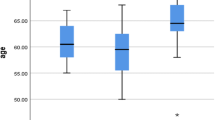Abstract
Etiology of sporadic Parkinson’s disease (PD) is largely unknown. The contribution of genetic factors to the pathogenesis of PD is supported by the demonstration of high concordance in twins, increased risk among relatives of PD patients and existence of familial cases. This study aimed to examine the relation between interleukin 18 (IL-18) gene promoter polymorphisms and idiopathic PD, and its impact on clinical presentation and disease severity. 30 idiopathic PD patients and 15 age- and sex-matched healthy subjects were included. Disease severity was assessed using Unified Parkinson’s Disease Rating Scale (UPDRS). Genetic testing for IL-18 gene promoter −607C/A single nucleotide polymorphisms (SNP) was done using real-time polymerase chain reaction (PCR) technique. A raised risk of PD development was found in patients with A/C and C/C genotypes of the site −607C/A (odds ratios = 1.83 and 1.98, respectively). The distribution of the genotypes showed no significant relation to gender or predominant clinical presentation. The age at onset of disease was significantly lower in C/C and A/A genotypes compared to A/C genotype (p = 0.001 and 0.04, respectively). Patients with A/A genotype showed significantly higher mentation score of UPDRS compared to patients with A/C and C/C genotypes (p = 0.003 and p = 0.002, respectively). Polymorphisms of IL-18 gene promoter increase the risk of developing idiopathic PD. The polymorphisms may affect phenotypic expression rather than being a direct cause of idiopathic PD.


Similar content being viewed by others

References
Fahn S, Przedborski S (2005) Parkinsonism. In: Rowland (ed) Merritt’s neurology. Lippincott Williams & Wilkins, Philadelphia, pp 828–846
Sugama S, Wirz SA, Barr AM, Conti B, Bartfai T, Shibasaki T (2004) Interleukin-18 null mice show diminished microglial activation and reduced dopaminergic neuron loss following acute 1-methyl-4-phenyl-1,2,3,6-tetrahydropyridine treatment. Neuroscience 128:451–458
Hunot S, Hirsch EC (2003) Neuroinflammatory processes in Parkinson’s disease. Ann Neurol 53(3):49–60
Pawlik A, Kurzawski M, Czerny B, Gawronska-Szklarz B, Drozdzik M, Herczynska M (2006) Interleukin-18 promoter polymorphism in patients with rheumatoid arthritis. Tissue Antigens 67:415–418
Yu JT, Tan L, Song JH, Sun YP, Chen W, Miao D, Tian Y (2009) Interleukin-18 promoter polymorphisms and risk of late onset Alzheimer’s disease. Brain Res 1253:169–175
Xu X, Li D, He Q, Gao J, Chen B, Xie A (2011) Interleukin-18 promoter polymorphisms and risk of Parkinson’s disease in a Han Chinese population. Brain Res 1381:90–94
Thompson LM (2008) Neurodegeneration: a question of balance. Nature 452:707–708
Jankovic J, Shannon MK (2008) Movement disorders. In: Bradley W, Daroff R, Fenichel G, Jankovic J (eds) Neurology in clinical practice. Butterworth Heinmann, Elsevier, Amsterdam, pp 2081–2122
Brusse KJ, Zimdars S, Zalewski KR, Steffen TM (2005) Testing functional performance in people with Parkinson’s disease. Phys Ther 85:134–141
Szumilas M (2010) Explaining Odds ratios. J Can Acad Child Adolesc Psychiatry 19(3):227–229
Hakansson A, Westberg L, Nilsson S, Buervenich S, Carmine A, Holmberg B, Sydow O, Olson L, Johnels B, Eriksson E, Nissbrandt H (2005) Interaction of polymorphisms in the genes encoding interleukin-6 and estrogen receptor Beta on the susceptibility to Parkinson’s disease. Am J Med Genet 133(B):88–92
Ross OA, O’Neill C, Rea IM, Lynch T, Gosal D, Wallace A, Curran MD, Middleton D, Gibson JM (2004) Functional promoter region polymorphism of the proinflammatory chemokine IL-6 gene associates with Parkinson’s disease in the Irish. Hum Immunol 65:340–346
Infante J, Garcia-Gorostiaga I, Sanchez-Juan P, Sánchez-Quintana C, Gurpegui JL, Rodríguez-Rodríguez E, Mateo I, Berciano J, Combarros O (2008) Inflammation-related genes and the risk of Parkinson’s disease: a multilocus approach. Eur J Neurol 15:431–433
Paisan-Ruiz C, Jain S, Evans EW, Gilks WP, Simón J, van der Brug M, López de Munain A, Aparicio S, Gil AM, Khan N, Johnson J, Martinez JR, Nicholl D, Carrera IM, Pena AS, de Silva R, Lees A, Martí-Massó JF, Pérez-Tur J, Wood NW, Singleton AB (2004) Cloning of the gene containing mutations that causes PARK8-linked Parkinson’s disease. Neuron 44:595–600
Haugarvoll K, Uitti RJ, Farrer MJ, Wszolek ZK (2006) LRRK2 gene and tremor dominant parkinsonism. Arch Neurol 63:1346–1347
Healy DG, Falchi M, O’Sullivan SS, Bonifati V, Durr A, Bressman S, Brice A, Aasly J, Zabetian CP, Goldwurm S, Ferreira JJ, Tolosa E, Kay DM, Klein C, Williams DR, Marras C, Lang AE, Wszolek ZK, Berciano J, Schapira AH, Lynch T, Bhatia KP, Gasser T, Lees AJ, Wood NW (2008) International LRRK2 consortium. Phenotype, genotype, and worldwide genetic penetrance of LRRK2-associated Parkinson’s disease: a case–control study. Lancet Neurol 7:583–590
Hashad DI, Abou–Zeid AA, Achmawy GA, Saad-Allah HM, Saad MA (2011) G20195 mutation of the leucine-rich repeat kinase 2 gene in a cohort of Egyptian patients with Parkinson’s disease. Genet Test Mol Biomark 15(12):861–866
Acknowledgements
The authors acknowledge subjects for their participation and cooperation.
Funding
Personal funding by the authors themselves.
Author information
Authors and Affiliations
Contributions
All authors were involved in protocol development and data analysis. SS carried out the molecular genetic studies. EF wrote the first and final draft of the manuscript. AK was involved in patient recruitment. EF and HH reviewed and edited the manuscript and approved the final version of the manuscript.
Corresponding author
Ethics declarations
Conflict of interest
No potential conflict of interest relevant to this article is reported. No official funding.
Ethical approval
The study was approved by the Ethical committee of the institution.
Infomed consent
Patients were informed, and they consented to conduct the study.
Rights and permissions
About this article
Cite this article
Fahmy, E., Rabah, A., Sharaf, S. et al. Interleukin-18 promoter polymorphisms and idiopathic Parkinson disease: an Egyptian study. Acta Neurol Belg 119, 219–224 (2019). https://doi.org/10.1007/s13760-018-0927-7
Received:
Accepted:
Published:
Issue Date:
DOI: https://doi.org/10.1007/s13760-018-0927-7



